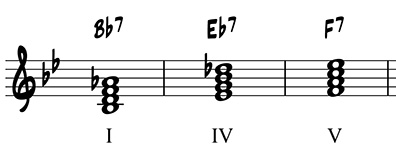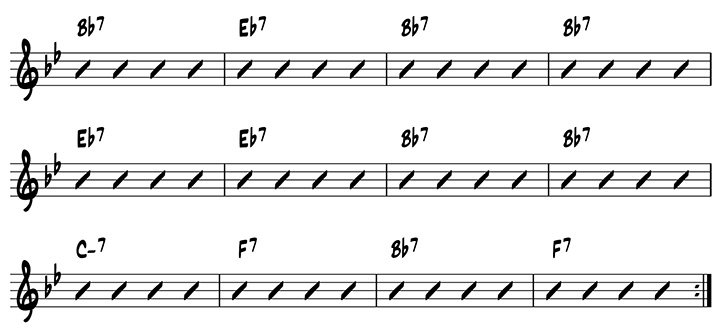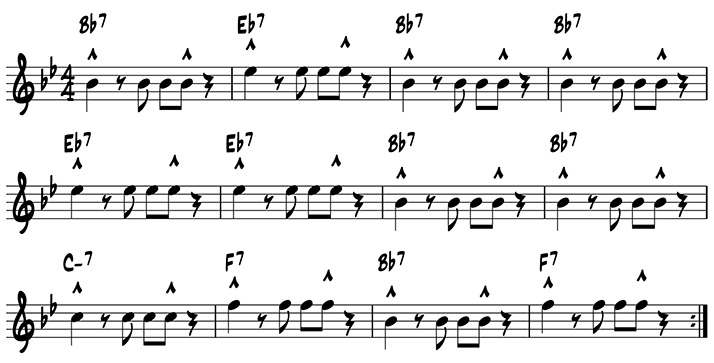Index - Introduction - Lessons
One-measure riffs on the roots of each chord of the blues
The term form is used to describe the structure of a piece of music. In jazz, we also use form to indicate the length of the composition and the order in which the chords occur. Most jazz pieces and standard compositions consist of a specific number of measures which are repeated many times. Playing from the first measure to the last measure of the form is called a chorus. Usually, a melody will be played on the first chorus of a piece, followed by several choruses of improvisation, and a return to the melody on the last chorus.
Lesson 2 applies the concepts of Lesson 1 to the blues form. Your main goal is to learn the form of the blues and to memorize the order of its harmonies. At this point in the lessons, you do not need a complete understanding of theory, but some basic knowledge can be helpful. To learn more about chords and harmony, visit FundamentalsOfMusic.com.
What makes a composition a blues?
There are many variations on the blues form, with several alternate chord possibilities. For now, the most important thing for you to know is that the blues is based on three main harmonies: The chords of the first, fourth, and fifth scale degrees of the selected key. Therefore, in a B flat blues, the main harmonies are B flat 7, E flat 7, and F7. We often use Roman numerals to represent those harmonies, as shown below.

The blues is typically a twelve-measure form. There are variations on the length of the blues, but for the purpose of these lessons, we will use the twelve-measure or twelve-bar blues. The play-along recording features several repeated choruses of the blues.
Later in this method, we will explain the chords in greater detail, but for now, our main focus is to memorize the roots of each chord and the form of the blues. Throughout this method we will use a basic blues progression with the following chord structure. It has the I, IV, and V chords listed above, with the addition of the ii chord (C minor).

Part 1: Compose
Compose a one-measure rhythmic riff. Write that riff on the root of each of the chords of the blues progression following the order of the harmonies, as shown in the example below. For blank sheet music, visit Music-Paper.com.

Suggestions: Make your riff simple and easy to remember. Your main focus in this assignment is to memorize the form of the blues. Include some rests in your riff, especially if you play a wind or brass instrument. Twelve measures of non-stop playing can be tiring for you (and for the listener).
Part 2: Memorize
Memorize the solo that you composed and play it many times. Repeat the solo until you do not have to think about the order of the chords. Your goal is to play effortlessly so that you instinctively know where you are in the form at all times.
Part 3: Improvise
Improvise in the same manner as the written solo that you composed. Create a one-measure riff on B flat in the first measure and play that same rhythm on the root of the rest of the chords of the blues. Improvise in this way until you instinctively know what chord occurs in each measure. Practice improvising without looking at the music. If you get lost, you can check the music when necessary, but your goal is to be able to play and improvise over the tune without having to look at a sheet of music.
Suggested exercises for solo practice:
Play a single rhythmic riff over the whole form of the blues. After you have completed the first chorus, improvise a new riff in the first measure and repeat it through the rest of the form. Repeat this process many times.
Trade fours with yourself and play a new riff every four measures of the blues. When you can trade fours with your self effortlessly and accurately, trade twos and ones with yourself.
Trade fours with silence: Improvise a one-measure idea and repeat it three more times on the root of each chord, creating a four-measure phrase. For the next four measures, remain silent but be aware of where you are in the form.
The more you mix up the your practice methods, the more quickly and efficiently you will learn the form of the blues.
Suggested exercises for group practice:
Trade choruses with musicians playing a riff on the root of each chord of the blues.
Trade fours, twos, and ones with each musician, as well. As with the solo practice suggestions, including silence within the fours is also a good exercise.
Lesson 3: Introduction to harmony, improvisation on scale degrees 1 and 3

If you like this site, please share it with others!


Like Kyle Coughlin Music on Facebook
Follow Kyle Coughlin Music on Twitter